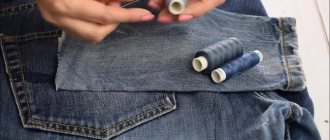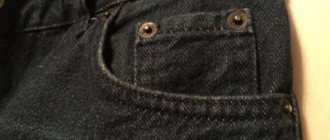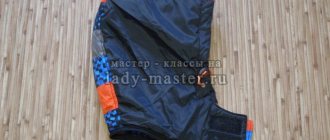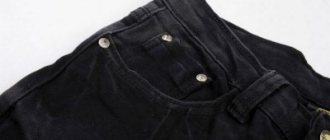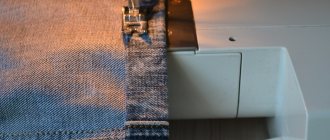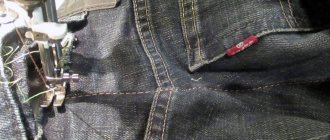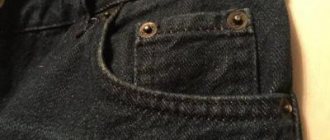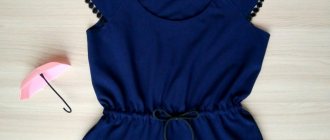If the donated jeans turned out to be too big, or your favorite ones began to hang loose, this is not a reason to be upset. In most cases, you can reduce jeans by one or even two sizes yourself, without resorting to the services of a tailor.
There are two main ways to solve the problem:
- perform moisture-thermal shrinkage of the product;
- sew jeans.
The choice of method depends on the type of fabric, model of trousers and how much you want to reduce them. If the pants are a little too big, you can get by with a simple shrinking procedure, but this method is not suitable for all types of jeans. Large differences in size can only be corrected using a sewing machine.
Why is the procedure needed?
Why make jeans smaller when clothing stores already have enough choice?
Firstly, we are not all perfect, and often choosing pants that fit our figure becomes a big problem. Sometimes it’s wide at the waist, sometimes it’s narrow at the shins, and you also have to hem it and remove the length. Thanks to special washing conditions, you can adjust the model you like to suit you. Secondly, not all types of denim are wear-resistant. You will have to reduce the size of your pants if they are stretched. The product itself looks good, emphasizes the figure, only the elongated knees spoil everything. Some people don’t want to splurge on new pants every time the problem of pulling out the old ones arises. The procedure will also help those who have suddenly lost weight.
At home, you can make clothes one size smaller with just washing. It is unlikely that it will be possible to reduce an item by 2 sizes; in such cases it is better to resort to a sewing machine.
Adviсe
It is worth remembering that you cannot make trousers a size smaller only in length or width - jeans always fit evenly. Therefore, when purchasing, choose a length up to your heels (as a last resort, you can always hem them). Manufacturers advise taking jeans a size smaller, since after frequent wear they will stretch in any case.
Stretch denim trousers cannot be reduced; on the contrary, they only stretch over time. These jeans may shrink a little after washing, but they will stretch out again as the day goes on.
Not all jeans can be made smaller by washing or special drying. In some cases, you need to take drastic measures - take the trousers to the workshop and have them recut to fit. Do not take on this work yourself without sufficient experience: if the jeans are very large, you will have to rip out not only the side seams, but also the crotch seams. Moreover, you won’t be able to make a special “denim” seam using a regular sewing machine. In the workshop you can not only reduce the size of your trousers, but also adjust their cut. Of course, this method is the most reliable.
About the author:
Found a mistake? Select the text with the mouse and click:
Do you know that:
Threads made of gold and silver, which were used to embroider clothes in the old days, are called gimp. To obtain them, the metal wire was pulled for a long time with pliers to the required fineness. This is where the expression “to drag out the rigmarole” came from - “to do long, monotonous work” or “to delay the completion of a task.”
Features of denim fabrics
Jeans began their march around the planet in the middle of the 19th century as an item of clothing for a working man. Both pants and other products, shirts, jackets, were made of dense, coarse cotton, which gave maximum wear resistance and durability. Over time, jeans took over the world, moving into the category of casual wear. The global increase in importance is driven by developments that improve the appearance and functionality of fabrics.
The following types of denim fabrics are distinguished:
- Denim. You will have to pay a decent amount for jeans made from real denim. But the price is worth it. They contain exclusively natural, high-quality raw materials. A distinctive feature is the color: blue on the front and white on the back. They are not afraid of high temperatures - washing up to 90 degrees is acceptable.
- Jean. If you compare denim and gin, they are the exact opposite of each other. Gin is distinguished by its availability, which, unfortunately, comes with low quality. The coloring is identical for both sides. A special feature is considered to be imaginary shrinkage. Jeans washed in hot water visually shrink in both volume and length. In fact: the fabric will shrink only temporarily. One of the advantages, perhaps, is that along with the size, the softness lost during shrinkage will return.
- Stretch. Skinny jeans that embrace every curve of the body with a gentle embrace are sewn from an elastic material called “stretch”. To obtain the existing result, according to the technology, elastic threads are added to coarse fabrics, such as denim. The result is an ideal symbiosis that gives a wonderful aesthetic appearance and a comfortable feeling when worn. The aesthetics of the product are undermined as soon as the jeans begin to stretch, which cannot be avoided with constant, intense wear. Hand washing using hot water and natural drying will correct the situation.
- Chambray. Of all denim fabrics, chambry is characterized by its fragility: things made from the fabric wear out quickly and tear easily. After washing in hot water or boiling, they shrink significantly. This is due to the fact that the density of chambrie is much less than that of high-quality denim. But it is precisely this indicator that makes the fabric an ideal material for things for the summer.
The composition of the fabric gives jeans the ability to stretch and shrink. There are effective methods that can reduce the size.
Types of denim fabrics
The first jeans were released in the middle of the 19th century. Pants, jackets and shirts sewn from thick, coarse indole-colored cotton were used as work clothes. Today, textile manufacturers produce several types of denim, which differ in production and dyeing technology, appearance, care methods, and price.
- Denim is a high-quality material made from raw materials collected on plantations in Mexico, Barbados and Zimbabwe. The front side of the fabric is blue, the back side is white. Denim jeans cost several thousand, but the quality justifies the price. These pants fit like a glove, clearly hugging the contours of your figure. They can be washed in water heated to 90 degrees, dried in a machine or in the sun - the fabric will only become stronger.
- Jean is a cheap, soft cotton denim of low quality, entirely dyed in one color. Used for sewing budget clothes. The material is difficult to shrink. If the product is washed in hot water, the fabric will become rough and shrink a little, but will soon restore its texture and the pants will stretch again. When shrinking, not only the volume, but also the length of the product will decrease.
- Stretch is an extremely elastic material from which narrow, tight jeans are sewn. The flexibility of the initially rough denim is given by the lycra fibers that make up the weft threads. Stretched stretch pants look unaesthetic. To return the product to its original appearance, you need to wash it in hot water by hand and dry it in the sun.
- Chambray is a light, thin cotton from which summer shirts, dresses, and tunics are sewn. The density of this type of fabric is half that of classic denim. Items made from chambry are short-lived, quickly tear and wear out, and rarely survive until the new season. After washing or boiling, chambry pants shrink greatly in length and width.
Before experimenting with jeans, trying to reduce their size by hand or automatic washing, soaking or boiling, you need to study the composition of the material from which the product is made and the manufacturer's care instructions. You should not check on expensive pants whether they will shrink after washing - this can ruin the product forever.
At what temperature should you wash jeans to make them shrink?
This method is suitable for natural fabrics, in which cotton predominates, and its amount must be at least 70%.
Such washing will only harm artificial fabrics; they will stretch and lose their appearance.
You should not wash things in this way that are heavily decorated with rhinestones, stones and delicate materials, such as ruffles. They will become unusable, and, moreover, they will clog the machine. As a result, both the trousers and the unit will be damaged.
Jeans made of high-quality and thick denim can be periodically subjected to this type of washing, but not often. If you regularly use such methods of shrinking items in a washing machine, the product will quickly become unusable.
Washing is a proven method for reducing clothing sizes over the years. Everyone knows that a washed item is much more difficult to put on and fasten.
Washing helps reduce stretched jeans at the hips and out-of-shape fabric at the knees. But the effect will be short-lived, and after a while the product will stretch out again.
- To increase the washing effect, use hot water.
- In terms of effectiveness, hand and machine washing are not the same, since in the washing machine you can increase the temperature to 90, causing the fabric to shrink. Thanks to the high temperatures and high speeds in the washing machine, jeans can be reduced up to two sizes. When washing by hand, you cannot use such hot water.
Not only hot water will help reduce the size of jeans, but also the correct method of drying after washing. Various methods can be used.
- After the product has been washed and thoroughly wrung out, it should be hung to dry over a heat source, heater or radiator. This will increase the rate of moisture evaporation after washing, which helps to compress the fibers and reduce the size of the jeans.
- You can dry your jeans by laying them on a fabric that absorbs moisture well, such as a terry towel. The fibers will absorb water and the pants will “shrink.”
- Jeans washed in hot water can be placed in the dryer on a high setting. This will significantly “shrink” the fabric.
If you did everything correctly, your jeans will shrink by at least one size.
Washing jeans in hot water
The simplest, fastest and at the same time effective way is considered to be washing jeans in hot water, which causes the fibers to tighten, causing the item itself to become slightly smaller in size, which makes it more comfortable to wear. To do this, you need to put the jeans in the washing machine and turn on the wash cycle at a temperature of 95 degrees, since this will be just enough for the item to change size.
An important point is that you need to stop the machine before the cold water rinse mode starts. Repeating a similar hot wash several times is an excellent opportunity to reduce the size of the item, making it more comfortable to wear. When washing jeans in hot water, their attractiveness is not affected, since the fabric simply tightens without disturbing the overall appearance of the item, which prevents discomfort when wearing.
Boiling jeans in boiling water
If it is not possible to use a washing machine, then you can use boiling water and boil the jeans, giving them the correct shape and size depending on the need. But it is worth considering the following important details:
- First, you need to boil water in a saucepan.
- Jeans are placed there using tongs.
- You need to boil the product for 20-30 minutes, and you need to be careful not to overcook the product.
It is necessary to use special tongs for safety reasons, so do not neglect this rule! It is also important that if the technology is violated, the product may lose color and shape, completely damaging the item. And that is why it is important, after such a hot wash, to drain the water from the pan, and use tongs to lay the jeans on a flat horizontal surface to drain the water and dry.
The correct attention to detail in terms of reducing the size of jeans is the basis for their convenient subsequent use, and that is why you need to take special care in this matter.
What not to do when trying to make your favorite jeans smaller?
It is quite possible to make jeans smaller at home. However, this matter should begin with careful preparation, not forgetting the following rules and taboos:
- It is prohibited to boil items decorated with rhinestones, appliqués, or lace. Boiling will ruin them hopelessly.
- Stretch jeans probably won't be able to be made smaller. They cannot be boiled at all: hot water will destroy the elastic threads. To change their size, you will have to sew the item.
- If you decide to shrink your jeans using a needle and thread, they should be washed first. After this, they will shrink, and it will become clear how exactly they need to be sutured.
- There is no need to iron dry your denim pants. This method will not “seat”, but will stretch the thing.
- Sewing denim pants is impossible at home for those who do not have a sewing machine. For those who have no sewing skills at all, it is better not to risk it, but to take the item to a workshop.
Few people try to alter jeans at home without the help of a specialist. However, learning to cope with such a task is within the capabilities of any housewife, so there is no need to be afraid. Everything is possible if you want and practice a little on trousers that you don’t mind ruining.
Why do jeans stretch?
Denim material is made from durable and thick cotton thread. It is strong to tear, but stretches well. Because of this, with constant stretching of the fabric, jeans lose their original shape. This is especially noticeable on the knees (those unattractive bubbles) and waist. Adding synthetic threads improves the situation slightly. They are rubberized and therefore return more easily to their original shape, maintaining elasticity.
These details are of important practical importance. Stretch jeans, which are usually made with a high synthetic content, practically do not shrink after a hot wash. The best way to reduce them is to suture them. More natural denim (70% cotton or more), on the contrary, shrinks greatly from high temperatures. Therefore, jeans with a small percentage of synthetic fibers or no synthetic fibers can be washed to reduce them by size.
Check the fabric content on the tag
How to make jeans dry out
Even more than from hot water, jeans will shrink from aggressive and hot drying. Wash your jeans in a washing machine (any mode), spin at maximum speed, and then use one of the following methods:
- You can dry your jeans using a working central heating radiator.
If you have a control valve, set it to maximum heat. It is best to purchase a special dryer that is attached to the battery. This is the simplest but least effective method. With its help, jeans will shrink just a little, so it is suitable for returning a tight silhouette to old skinny jeans that were a little worn out; Such dryers cost about 50–100 rubles and are sold in hardware stores and departments with fixed prices - A hair dryer is also a good option.
Please note that during drying the device may turn off due to overheating of the motor. This is normal, just wait a few minutes for it to cool down and turn it back on. Lay your jeans out on a table or floor and press the edges of your pants down with books or other heavy objects. On the other hand, insert the hair dryer with the nozzle inside the product, wrap the body tightly with a belt and turn on the hair dryer at maximum power and temperature. If you did everything correctly, the jeans will inflate. They need to be kept this way until they are completely dry; This drying will shrink the jeans more or less evenly. - It's best if you have a dedicated dryer or have this feature added to your washing machine.
Everything is simple here - after washing, you need to run the most intense and aggressive drying mode. Drying and washing machines are expensive, but their presence in the house is often justified - at least with their help you can easily shrink jeans
Drying can also be used for local reduction of jeans, for example, only on the hips or on sagging knees. To do this, moisten the problem area with a spray bottle, and then dry using one of the above methods.
Methods for shrinking jeans
Enterprising housewives have come up with and tried a lot of ways to reduce excessively stretched jeans.
It is known that when there is a sharp change in temperature, natural fibers shrink greatly. Wool, cotton, silk, and linen inevitably shrink after washing. And if you immerse the product alternately in hot water and then in cold water, you can easily reduce your jeans by 1-2 sizes.
Hand wash
Hand washing is the safest, gentlest way to shrink jeans. It is used for clothes made from stretch or chambris.
In order for a thing to shrink in size and retain its new appearance forever, the following work must be done:
- Immerse the product in hot water (+60°C) for half an hour.
- Wash denim pants or shorts as usual, adding a little powder.
- Rinse in very cold (preferably ice) water. To achieve a sharp drop in water temperature, you can pour ice from the freezer into a basin.
Dry the product on a horizontal surface in a ventilated area.
Fabric softener
You can completely shrink your pants using the same fabric softener. This method is rarely used for all pants, but it is quite effective if you need to get the result quickly and in a pair of socks.
Need to:
- Mix 3 parts conditioner to 1 part water.
- Send the composition into a spray bottle.
- Distribute it over the entire surface of the pants.
- Dry the product at high temperature. You can do this even with an ordinary hairdryer.
This method with conditioner is especially good for stretched waistbands. In this case, it is precisely this that needs to be carefully treated with the concentrated resulting solution and dried with an iron.
Having altered
What can I do to make my jeans fit correctly? A good way is to sew it up. To do this you will need chalk or soap, scissors, a blade, thread of a suitable color and a needle, or you can use a sewing machine.
How to fit jeans into a waistband? The procedure is simple, but it will require a little personal time.
What do we have to do:
- Take a blade and open the seams on both sides of the pockets.
- Use scissors to remove any loose threads out of the way.
- Take the iron and iron all the parts, do not forget to set the correct temperature, it is indicated on the label.
- Take a centimeter and measure the circumference of the belt, transfer the resulting measurements to the fabric using soap.
- Using a brightly colored thread, baste the fabric to the new measurements. Then try on your pants. If the trousers fit well and the measurements are taken correctly, you can start sewing.
- Using a needle and thread or a sewing machine, sew the parts.
This method can be used if the jeans are very stretched at the waist, hips, bottom or knees.
Don't forget to take your measurements and place them correctly so that your pants don't end up too small.
You can’t do that “I’ll reduce it by eye, there’s only a couple of centimeters that need to be removed.” If you are an experienced seamstress and have picked up a sewing machine more than once, perhaps everything will work out. However, this method is not suitable for a beginner.
It is necessary to measure everything correctly and even double-check it more than once, try it on and walk around in your pants to make sure that the alteration of the clothes is done correctly.
Dry cleaning and atelier
If you are afraid to alter your pants yourself, and the risk of ruining the item is high, it is better not to try to alter them.
Contact a good studio. Experienced craftswomen will measure your volume and sew your pants to the required size.
The second option is to take them to the dry cleaner, indicating that they need to be made smaller in size. Perhaps such a service will cost a little more, but it is better if you doubt your abilities.
Local shrinkage
The most difficult way is to reduce the size of not all pants, but only certain areas of them. It may be relevant if, for example, the knees, bottom, pockets of jeans or any other part of them are stretched due to improper drying. This often happens when slightly damp pants are left hanging on a hook.
Then the part with which they are caught can stretch noticeably. There is no need to wash your pants for local shrinkage.
You only need:
- Dilute fabric softener with water. The solution should be concentrated: 3 to 1.
- Fill a large spray bottle with the product.
- Spray the mixture generously onto problem areas. They should be noticeably moisturized.
- Throw your pants into the dryer.
The product must be dried at high temperatures. Then the stretched fibers of the fabric will noticeably tighten.
Shrinkage exactly to your figure
An extreme method for those who want to narrow their jeans so that they fit like a glove. The essence of the method is as follows: put on trousers and sit in a bath with hot water.
When the water cools down, you can get out of the bath, but the torment doesn’t end there, since now you’ll have to dry your jeans on yourself without taking them off. It is better to do this in a sunny clearing, exposing one or the other side to warm rays for uniform drying.
We sew according to the figure
Along the side seam
This method is suitable for uniformly reducing jeans along the entire length:
- Put on your jeans and make a basting parallel to the side seams so that it fits you properly. The basting should run from the very top of the jeans to the beginning of the thigh along both legs.
- Take off your jeans and measure the distance from the side seam to the basting.
Let's take 2 centimeters as an example - this allows you to reduce jeans by exactly one size. All further steps must be performed with both legs. - From the right side, extend the side seam line on the waistband using a cutting chalk. Mark the distance from the previous step on both sides of the resulting line. Turn your jeans inside out. Extend the side seam line again with chalk.
- On both sides of the side seam and its continuation on the waistband, mark with chalk the distance we got in step 2. In our example, it is 2 centimeters.
This way we get an “extra” strip 4 centimeters wide, running parallel to the side seam. You should now have two parallel lines on either side of the side seam. - Let's move on to tearing.
Turn the jeans right side out. You need to rip out a small section of the seam connecting the belt to the rest of the product. We will separate the parts according to the marked width, increasing it by a couple of centimeters for convenience. Do the same with the upper side of the belt, which connects the front and inner parts. Mark this extension in advance with a chalk - The bottom hem of the pant leg (if your jeans have one) also needs to be unraveled. The most convenient way is to rip it off entirely.
The bottom hem can be ripped off entirely to make it easier to work with later
- Now you need to rip the side shock itself from top to bottom.
- Turn the jeans inside out and iron thoroughly at maximum temperature.
At this stage you should have an even marking for sewing the legs - Align the edges of the fabric and secure them with pins.
At this stage we protect ourselves from accidental tissue shifts - Sew along our drawn line from the very top of the leg to the bottom, without touching the waistband. It is best to do this with a machine - by hand the seam will be uneven, and you will spend a lot of time on it.
- If necessary, you can trim the remaining allowances so that they are 1.0–1.5 cm. Then they need to be processed with an overlocker. If you don't have one, use a zigzag stitch on a machine.
- Turn the jeans right side out.
Return to our notes on the belt. It is necessary to cut the fabric along the center line, which, as we remember, is a continuation of the side seam. You'll need the sharpest scissors - the waistband is the thickest and strongest part of the jeans - Now you need to sew the belt.
To do this, sew the belt pieces together in pairs with right sides facing inward. Such details are ironed down. You should now have four separate pieces of fabric that need to be stitched in pairs. - Sew the resulting two pieces on top along the front side.
Try to get the side stitching into an existing seam to make the jeans look aesthetically pleasing. Typically the distance between the top edge and the seam is about 1mm, so be very careful with this step - Wrap the main part of the jeans inside the waistband through the hole that remains on the bottom side.
Simply put, return the belt to the position it was in before unraveling. Sew along the opened seam lines. Here, as in the previous step, you need to ensure that the seam is even so that the jeans turn out beautiful. - Fold and stitch the bottom edge of each leg. Make the seam as even as possible because it will be visible from the outside.
Methods for restoring jeans after shrinkage
Denim fabric has the ability not only to stretch, but also to shrink. Therefore, sometimes it becomes necessary to restore it after shrinkage. For example, after an unsuccessful wash. There are several effective ways to do this. All of them are simple, budget-friendly and accessible to everyone.
Cold and hot shower
It may be that jeans cannot be washed in an automatic washing machine. Give them a contrast shower.
First rinse the pants in very cold water, then put them in boiling water. Since you won’t be able to wash at this temperature, wait until it cools down a bit. If possible, leave the jeans in ice water overnight and wash them hot the next morning using laundry detergent or gel.
Important: the powder or other product should not contain bleaching agents, otherwise the jeans will lose color and have an unsightly appearance.
Iron
Another way to make jeans fit true to size. In this case, it is not necessary to wash them in hot water or boil them. Here you can get by with a regular iron. You will also need an ironing net or gauze or thin chintz.
Before you start ironing, look at the label at what maximum temperature you can iron your jeans. Next, thoroughly moisten them with warm water. Then squeeze lightly and start ironing, setting the desired temperature. Don't forget to cover your jeans with mesh or gauze to prevent shiny streaks from the hot iron.
Spraying
For this simplest method, ordinary water is used. You don't need to add any special products to it. The thing is that wet denim stretches perfectly. This method is suitable for changing the size of individual sections of the product or entire pants.
Need to:
- Pour water into a spray bottle.
- Spray it on problem areas or the entire thing.
- Make sure the fabric is saturated with water.
- Begin to gently stretch the material to the sides. All buttons must be stretched so that the material does not tear.
To make the task easier for yourself, you can put the pants that need stretching on yourself while they are wet and walk around in them. The main thing is not to try to stretch the fabric in places where it is too thin, frayed, or already has holes. Clothes stretched in this way will retain their new size until the next traditional wash.
If doing exercises in wet clothes is unpleasant, you can use improvised means to stretch them. In this case, the problem areas of the product need to be pulled onto a bottle, hanger, mannequin or other suitable objects. Just let them dry.
Length stretch
Jeans sometimes become shorter during the washing process. This is no less a serious problem than reducing their width. You will have to be patient to get your pants to fit properly. There are 3 main ways to do this.
How to Shrink Jeans by Washing
Surely your jeans have shrunk at least once after an unsuccessful wash. If you approach the matter wisely, you can use this feature for good and return the shape of the old product. These methods, as mentioned above, are mainly suitable for denim with a low synthetic content (up to 10%). However, a cheap product with low-quality synthetic threads can also shrink from such procedures.
Machine washable
The easiest way to carry out the procedure is in a machine:
- Empty the drum and place only the jeans in it.
- Set the maximum water temperature (usually 90 degrees) and the maximum spin speed.
- Add fabric softener.
It will prevent the jeans from becoming excessively stiff (oaky) after shrinking. Washing powder or gel can also be added if desired. It will not prevent the product from shrinking. - Wash your jeans on the most intensive cycle.
- Remove the product and dry it horizontally.
If you don’t have a washing machine at hand, use boiling water. You will need large tongs for styling jeans and a pan in which the product fits completely:
- Boil water in a saucepan.
- Place the jeans in boiling water using tongs.
- Boil them for 20–30 minutes. The process must be monitored at least once every five minutes. Jeans will not be able to burn to the pan, but the gurgling water will periodically push them to the surface. Your task is to use tongs to immerse them back.
- Drain the water and wait for the jeans to cool slightly to avoid burning yourself. Be especially careful with metal parts (buttons and fly).
- Dry your jeans horizontally.
Different drying methods
When shrinking denim pants, drying is very important. This is what helps you end up with a smaller version of your favorite wardrobe item.
There are several options for proper drying:
- vertical and horizontal (in the second case, it is worth placing natural fabric under the item so that it absorbs excess moisture);
- using an automatic dryer (jeans that need to be smaller should be dried at maximum);
- any heater.
In extreme cases, you can use a hairdryer to dry things. But this is a rather long process and clothes may dry unevenly.
Air drying
You can adjust denim trousers to the desired size by drying them in the sun. To do this, fill the bathtub with high-temperature water, put on jeans and sit in the water.
The temperature should be quite high, but comfortable. Half an hour later they go out into the sun and dry their jeans on their bodies. Under the influence of heat emanating from the sun's rays, the product narrows.
An easier way: soak the product in hot water and hang it to dry in direct sunlight.
Drying denim trousers to shrink them is also practiced in a bathhouse. When exposed to steam, denim shrinks significantly.
Instead of a bathhouse, they use a bathroom: they fill up with very hot water and close the door tightly. Jeans are hung over steam and kept for an hour. The trousers are taken outside and completely dried in the sun.
Machine drying
Moistened, steamed denim trousers are placed in the drum of the washing machine.
Set the “Drying” mode on the panel and select the highest value. Under the influence of steam, the fibers of the fabric contract and the pants become smaller.
If all else fails, you can stitch it in!
If after washing, boiling, and quick drying it was not possible to reduce the size of denim trousers, there is only one thing left to do - sew in the jeans. The masters of sewing salons will quickly and efficiently sew from denim fabric . But such services cost a lot of money.
Therefore, having carefully studied the features of altering stretched jeans, you can safely get to work.
Algorithm of actions:
We prepare the necessary tools: thread, sharp scissors, needles, sewing machine (preferably with an overlocker), chalk or pencil, iron.- We rip the seams on the jeans in problem areas, remove old threads and carefully smooth the fabric.
- Focusing on the new parameters, we make markings with chalk.
- We sew the jeans along the new lines and try on the product in order to evaluate the quality of the fit of the product.
- After all changes have been corrected, we sew new seams on a sewing machine.
- We cut off the excess fabric, process the edges using an overlocker or sew it by hand.
Waist
The easiest way to change the width of a belt is to sew an elastic band into it . To do this, an incision is made on the back of the belt through which a wide elastic band is threaded. Fixed at the edges of the belt, it gathers it, thereby reducing the volume of the jeans at the waist.
Along the hips
In order to adjust the upper part of the jeans along the hip line, you need to do the following:
- Carefully remove the belt and rip the jeans along the hips. The experts also recommend ripping off the back pockets (their location on updated jeans most often changes)
- Using fitting, we fix the new hip line with pins, trying to make the transition from the factory line to the new line less noticeable.
- After the fitting is completed, we sew new lines on a sewing machine. Excess fabric is cut off only after the alteration of denim trousers is completed.
- Sew on the waistband and back pockets.
In order for the alteration of jeans to look as neat as possible, you need to very carefully select the shade of the thread for the external decorative seam.
This video will show you how to sew jeans:
How to fit a certain area of jeans (on the buttocks, hips, knees)?
Thin knees, voluminous buttocks, rounded hips - this is not the whole list of flaws in the female figure that ladies struggle with all the time.
All these features leave their direct imprint on the trousers, which over time lose their shape and stretch out in certain places.
To make them fit like a glove, even after the 30th dressing, you can apply the following steps:
- mix laundry conditioner with water and pour the mixture into a spray bottle;
- spray the composition onto those areas of the trousers that are stretched out;
- put the item in the washing machine and turn on the most powerful drying mode (with a maximum temperature of 90-95 degrees).
Advice! After such manipulations, the trousers should fit your figure. If this does not happen, then you need to repeat the procedure.
How to expand a thing in a certain place?
- take the pant leg in the area of the inner seam where the length begins from the knee to the shin;
- gently pull along the seams several times.
This method is not suitable for denim pants that have holes or slits.
Effective recommendations:
Spray the top of the product with warm water
It is important that the tissue is sufficiently moistened for subsequent manipulations. You need to stand in the place where the front pocket is located.
Take in your hands the part where the second pocket is located. Pull the fabric 10-15 times wide.
Initially, jeans have good stretch, but we stretch them every time we wear them. Over time, the material becomes less elastic and begins to sag in some places, and the pants begin to fall off the waist.
Washed jeans are much more pleasant to wear. After all, after this they shrink a little, but stretching still occurs over time.
Since not everyone has the opportunity to wash every day, experienced housewives have come up with another option on how to make jeans shrink.
What to do if your jeans are stretched:
- Take an empty spray bottle. Pour warm water into it.
- Lay the pants out on a flat surface and treat those areas that have become stretched during the day.
- Wet the cloth well so that the water begins to drain from this area. Otherwise, the desired result will not be achieved.
- Place the item in the dryer and turn on the most powerful drying and spin setting.
This method is suitable for daily use. You can repeat the procedure several times to reduce your jeans size.
Misconception
Some housewives advise moistening the desired area and putting the item on yourself. Try this method and sit on a chair, what will happen?
What will happen is that the material will stretch even worse. This method is not suitable if you are looking for a way to reduce jeans size.
Washing to shrink worn and new jeans
Experienced fashionistas advise buying jeans a size smaller - they fit beautifully, highlight your figure, and after washing they retain their shape better than those bought true to size. But it’s not always possible to do this, and your favorite trousers become too big after wearing them a few times. In order for them to return to their original shape (shrink), they must be washed properly. This can be done in two ways: manually or using a washing machine.
- Handwash. No matter what type of pants you wear, hand washing will shrink them a little, but not too much. The reason is simple - water temperature. When washing by hand, it is impossible to use hot water or boiling water. If you do this, you can burn your hands. Therefore, experts recommend machine washing for those who want to make their denim pants smaller.
- Machine washable. The ideal solution for those who want to make their trousers tighter. It doesn't take much effort to wash them in the washing machine. It is enough to load the laundry into the drum, pour washing powder (preferably gel) into a special compartment, select the desired mode, namely washing at 90 degrees, and start the wash.
You don't need to add any special detergents to make your jeans shrink. Simply wash them in hot water, wring them out thoroughly and dry them properly. Many people use an iron for this purpose. Indeed, after washing, you can iron your trousers with a hot iron.
Shrinking jeans with an iron
If a very small shrinkage of the pants is required, approximately one size, then there is no need for boiling or washing. All you need is an iron and an ironing net (can be replaced with gauze or thin chintz).
Procedure:
- Check the label of your pants for the maximum temperature allowed for ironing. They remember.
- Wet the jeans thoroughly with hot water.
- Press lightly without twisting.
- The iron is installed as per point 1.
- Cover the jeans with mesh to prevent shiny stripes from appearing.
- They try to dry their pants with an iron as quickly as possible.
The fabric is heat treated, but in a more gentle mode than when boiling.
Step-by-step instructions for boiling denim trousers
Before starting the boiling procedure, it is necessary to change the concentration of the proportions of the detergent. There is no point in buying expensive washing powder for this, because in this case the price has absolutely no meaning.
So, first you need to soak your trousers in the prepared solution for 20-25 minutes. Be careful, the water is boiling water. Then squeeze, dry, but do not iron. Otherwise, the fabric will return to its previous state.
After such a simple procedure, the clothes become smaller, they can be worn for some more time, then washed again in hot water, boiled, which will help return them to their previous size. In addition, remember that in 90% of all cases, the washing machine is to blame for why jeans become two sizes larger. Keep in mind that low water temperature, unreliable powder and delicate washing mode will not make any changes to the structure of the material.
We alter it
If the denim is stretchy or you want to make your trousers much smaller without losing color, you will have to sew them in. If you do not have sufficient experience in sewing, it is better to contact a tailor: the fabric is thick, the cut is quite complex (with stitching, with inset pockets, with loops and a label on the belt, etc.). Using a household machine, shrinking jeans is a task of medium to high difficulty.
Sew on the sides
If the jeans are too big along the entire length, then it is better to narrow them along the side seams. In most models, they are not reinforced with finishing stitching (except for a small area next to the pocket). Therefore, it is quite easy to perform such work without disturbing the original appearance of the product. You will only have to first remove the metal rivets on the pockets (if necessary).
Instructions:
- Do a fitting and use pins to outline how wide the finished jeans should be.
- After removing the trousers, turn them inside out and, in the places secured with pins, make chalk marks where the machine stitching will take place. On the waistband, mark with chalk where it joins the side seams.
- Remove the pins, undo the side loops, undercut the belt 10 cm on both sides of the side seams, also undercut the finishing stitching on the bottom of the product (if the jeans are narrow, it’s easier to remove it completely and then make a new one), remove the finishing stitches on the side seams (if they are available).
- Turn the product inside out and iron the side seams to mark the new seam lines more accurately.
- Draw a line for the new seam using the chalk marks using a ruler. Then match the side seams of both legs. First, pin them along the seams, and then along the intended line of the future stitch, which is repeated on the second trouser leg according to the pin marks.
- In the belt, from the pre-designated points of its connection with the side seams, step back the same distance to the left and right (for example, 2 cm, if you need to sew in 4 cm), draw lines along which the parts of the belt will be sewn, then add seam allowances of 1 cm and trim off the excess.
- Baste the product along the marked lines and try it on. If necessary, adjust the seams and, when the product fits the figure normally, sew them on a machine.
- Trim the finished seams by trimming 1.5 cm along the edges, then finish the edges with an overlocker or zigzag.
- Place a finishing stitch on the side seams next to the pockets, and hem the bottom of the trousers.
- Sew together the details of the belt, sew it at the waist, restore the stitching, and sew on the belt loops.
In this way, it is possible to alter the product by 2-3 sizes without any special disruptions in the cut. If there is a larger difference in size, you will need to rip out all the seams and cut out the parts according to the patterns corresponding to the required size.
How to sew along the middle back seam
If you need to reduce jeans by a size only at the waist, then it is better to do this by sewing them along the back seam and in the waistband. It is necessary to prepare threads not only to match the color of the fabric, but also to be as similar as possible to restore the finishing stitch.
Sequence of work:
- Make a fitting, marking with pins along the back seam and waistband how much you need to narrow the pants.
- Undo the back loop, then the waistband 10 cm on both sides from the back seam.
- Open the middle seam by 8-15 cm, so that the new line of the back seam smoothly transitions into the factory one. The more you need to sew, the longer the seam will need to be opened.
- In the waistband, mark a line with chalk at the junction with the back seam, then from this point in both directions mark half of the excess volume (if you need to remove 4 cm, then add 2 cm in both directions). Draw chalk along the marks of the stitching line for the belt parts, and then make seam allowances of 1 cm from them and cut off the excess.
- Using pins, mark a new back seam line with chalk, make a basting, try on the trousers and, if everything is fine, sew along this line.
- After joining the back seam, cut off the excess, leaving an allowance of 1.5 cm and overcast the edge using an overlocker or zigzag.
- Then perform a finishing stitch on the seam, sew on the belt and loop.
If you need to significantly reduce the waist of your jeans, then it is better to do this evenly, distributing the extra centimeters also along the side seams, so as not to disturb the cut. Then you will have to do the same work with the side seams, but the item will fit the figure better.
In most cases, shrinking jeans in different ways is quite possible at home. To do this, you need to choose the right option and follow all the recommendations.
Professional shrinking of jeans
Let's face it, using heat to shrink any material is always going to be risky. It's bad for the fabric, bad for the dye, and will never produce the results you want. Alternative? Take your ill-fitting jeans to someone who has made a career out of making clothes fit people.
Your local tailor will be able to discuss with you exactly how you want your jeans to fit and can then alter them accordingly. A pot of boiling water will never be able to offer the same level of service, so a real person will always be the best option when it comes to adjusting clothing.
How to make jeans 1-2 sizes smaller: effective ways
The most effective way is to throw them away. Yes, yes, just throw it away. If it’s a pity, you can give it to your girlfriends or one of your friends for whom they will be in time. But this is not a solution to the issue. Firstly, a good and stylish thing was not bought to give it away. Beautiful and expensive jeans do not deserve such treatment. Moreover, they fit the image perfectly.
But what can you do to make your jeans fit correctly? This is exactly the problem that owners of stylish trousers cannot find a solution for months. Thoughts about what to come up with involuntarily swirl in your head day and night, at work, and on public transport.
A true fashionista hates to throw away her favorite jeans. Let me remember how much I had to endure before I became their owner, how much I had to deny myself in order to buy a stylish fashion item. But this is not a reason to despair and give up earthly joys. Moreover, the jeans are made from a material that can always be made up a size, or even two, larger or smaller. The main thing is to know what to do to make your jeans fit. This task is easy to handle.
Wash
The method of hand washing with the effect of shrinking jeans involves contrasting temperatures. To do this, while rinsing the product, you need to transfer it several times from a container with very hot water to a container with ice water. Or, if time is of the essence, soak the jeans in very cold water for 8-12 hours, and then hand wash them at the highest possible temperature.
What needs to be done to make jeans shrink when machine washed? Wash at the highest possible temperature followed by intensive spinning. In practice it looks like this:
- Select the “Intensive” or “For wrinkle-resistant items” washing mode.
- Set the maximum water heating temperature.
- Pour washing powder into the cuvette. If desired, you can add a rinse conditioner, thanks to which the denim will not be “wooden” after washing and drying.
- Set the maximum spin and dry mode.
- Place the jeans in the drum and turn on the washing machine.
When the product is washed and dried, it is recommended to leave it in the machine drum for 10 minutes. If the shrinkage is insufficient, the procedure will have to be repeated according to the same pattern. It is not recommended to iron slightly damp jeans, as this reduces the shrinkage effect of the fabric.
We sew according to the figure
If you have thread, a sewing machine and basic sewing skills, you can make your jeans smaller by simply sewing them up. This method is the most effective and gives the most aesthetic result if you follow all the steps carefully and slowly. You can adjust the width of the updated product at any point with millimeter precision.
Along the side seam
This method is suitable for uniformly reducing jeans along the entire length:
- Put on your jeans and make a basting parallel to the side seams so that it fits you properly. The basting should run from the very top of the jeans to the beginning of the thigh along both legs.
- Take off your jeans and measure the distance from the side seam to the basting.
Let's take 2 centimeters as an example - this allows you to reduce jeans by exactly one size. All further steps must be performed with both legs. - From the right side, extend the side seam line on the waistband using a cutting chalk. Mark the distance from the previous step on both sides of the resulting line. Turn your jeans inside out. Extend the side seam line again with chalk.
- On both sides of the side seam and its continuation on the waistband, mark with chalk the distance we got in step 2. In our example, it is 2 centimeters.
This way we get an “extra” strip 4 centimeters wide, running parallel to the side seam. You should now have two parallel lines on either side of the side seam. - Let's move on to tearing.
Turn the jeans right side out. You need to rip out a small section of the seam connecting the belt to the rest of the product. We will separate the parts according to the marked width, increasing it by a couple of centimeters for convenience. Do the same with the upper side of the belt, which connects the front and inner parts. Mark this extension in advance with a chalk - The bottom hem of the pant leg (if your jeans have one) also needs to be unraveled. The most convenient way is to rip it off entirely.
The bottom hem can be ripped off entirely to make it easier to work with later
- Now you need to rip the side shock itself from top to bottom.
- Turn the jeans inside out and iron thoroughly at maximum temperature.
At this stage you should have an even marking for sewing the legs - Align the edges of the fabric and secure them with pins.
At this stage we protect ourselves from accidental tissue shifts - Sew along our drawn line from the very top of the leg to the bottom, without touching the waistband. It is best to do this with a machine - by hand the seam will be uneven, and you will spend a lot of time on it.
- If necessary, you can trim the remaining allowances so that they are 1.0–1.5 cm. Then they need to be processed with an overlocker. If you don't have one, use a zigzag stitch on a machine.
- Turn the jeans right side out.
Return to our notes on the belt. It is necessary to cut the fabric along the center line, which, as we remember, is a continuation of the side seam. You'll need the sharpest scissors - the waistband is the thickest and strongest part of the jeans - Now you need to sew the belt.
To do this, sew the belt pieces together in pairs with right sides facing inward. Such details are ironed down. You should now have four separate pieces of fabric that need to be stitched in pairs. - Sew the resulting two pieces on top along the front side.
Try to get the side stitching into an existing seam to make the jeans look aesthetically pleasing. Typically the distance between the top edge and the seam is about 1mm, so be very careful with this step - Wrap the main part of the jeans inside the waistband through the hole that remains on the bottom side.
Simply put, return the belt to the position it was in before unraveling. Sew along the opened seam lines. Here, as in the previous step, you need to ensure that the seam is even so that the jeans turn out beautiful. - Fold and stitch the bottom edge of each leg. Make the seam as even as possible because it will be visible from the outside.
